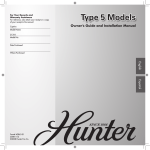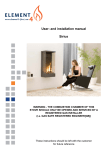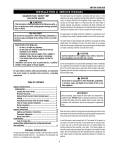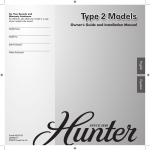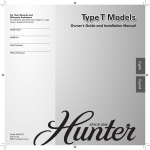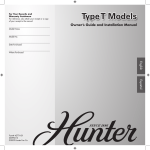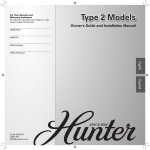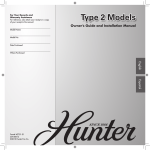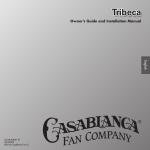Download Hunter Fan 41753-01 Fan User Manual
Transcript
For Your Records and Warranty Assistance For reference, also attach your receipt or a copy of your receipt to the manual. __________________________________________ Model Name Type 5 Models Owner’s Guide and Installation Manual __________________________________________ Model No. __________________________________________ Date Purchased __________________________________________ Where Purchased English Español Form# 41753-01 20100217 ©2010 Hunter Fan Co. Welcome Your new Hunter® ceiling fan is an addition to your home or office that will provide comfort and performance for many years. This installation and operation manual gives you complete instructions for installing and operating your fan. We are proud of our work. We appreciate the opportunity to supply you with the best ceiling fan available anywhere in the world. Before installing your fan, for your records and warranty assistance, record information from the carton and Hunter nameplate label (located on the top of the fan motor housing). Cautions and Warnings Table Of Contents Preparing the Fan Site . . . . . . . . . . . . . . . . . . 3 1 • Getting Ready . . . . . . . . . . . . . . . . . . . . . . 6 2 • Installing the Ceiling Plate . . . . . . . . . . 7 3 • Assembling and Hanging the Fan . . . 8 4 • Wiring the Fan . . . . . . . . . . . . . . . . . . . . . 9 5 • Installing the Canopy . . . . . . . . . . . . . . . 10 6 • Assembling the Blades . . . . . . . . . . . . . . 11 7 • Completing Your Installation . . . . . . . 12 8 • Operating and Cleaning Your Ceiling Fan . . . . . . . . . . . . . . . . . . . . . . . . . . . . . . . . 13 9 • Troubleshooting . . . . . . . . . . . . . . . . . . . . 15 • READ THIS ENTIRE MANUAL CAREFULLY BEFORE BEGINNING INSTALLATION. SAVE THESE INSTRUCTIONS. • Use only Hunter replacement parts. • To reduce the risk of personal injury, attach the fan directly to the support structure of the building according to these instructions, and use only the hardware supplied. • To avoid possible electrical shock, before installing your fan, disconnect the power by turning off the circuit breakers to the outlet box and associated wall switch location. If you cannot lock the circuit breakers in the off position, securely fasten a prominent warning device, such as a tag, to the service panel. • All wiring must be in accordance with national and local electrical codes and ANSI/NFPA 70. If you are unfamiliar with wiring, use a qualified electrician. • To reduce the risk of personal injury, do not bend the blade attachment system when installing, balancing, or cleaning the fan. Never insert foreign objects between rotating fan blades. • To reduce the risk of fire, electrical shock, or motor damage, do not use a solid-state speed control with this fan. Use only Hunter speed controls. © 2010 Hunter Fan Company 2 41753-01 • 02/17/10 • Hunter Fan Company Preparing the Fan Site Step 1 - Choose the Fan Site Proper ceiling fan location and attachment to the building structure are essential for safety, reliable operation, maximum efficiency, and energy savings. Choose a fan site where: • No object can come in contact with the rotating fan blades during normal operation. • e fan blades are at least 7 feet above the floor and the ceiling is at least 8 feet high. • e fan blades have no obstructions to airflow, such as walls or posts, within 30 inches of the fan blade tips. • e fan is directly below a joist or support brace that will hold the outlet box and the full weight of the fan. Checklist for Existing Fan Site If you want to use an existing fan site, complete the following checklist to determine if the site is acceptable and safe for your new Hunter fan. If you cannot check off every item, prepare a new fan site as described on this page. Fan Support System • Fan attaches directly to building structure. • Fan support system will hold full weight of the fan and light kit. Ceiling Hole • e outlet box clearance hole is directly below the joist or support brace. Outlet Box • e outlet box is an UL-approved octagonal 4” x 1-1/2” outlet box (or as specified by the support brace manufacturer). • e outlet box is secured to the joist or support brace by wood screws and washers through the inner holes of outlet box. • e outer holes of the outlet box are aligned with joist or support brace. • e bottom of the outlet box is recessed a minimum of 1/16” into ceiling. Wiring • e electrical cable is secured to outlet box by an approved connector. • Six inches of lead wires extend from outlet box. If your existing fan site is suitable, skip ahead to Section 2 • Installing the Ceiling Plate. 30” From Wall or Nearest Obstruction Fan Support System Fan Support System 3 41753-01 • 02/17/10 • Hunter Fan Company 7’ Minimum Blades to Floor 8’ Minimum Ceiling Height Suitable Existing Fan Site Outlet Box Wiring Preparing the Fan Site (continued) Step 2 - Cut the Ceiling Hole 2-1. Locate the site for the ceiling hole directly below the joist or support brace that will hold the outlet box and fan. 2-2. Cut a 4” diameter hole through the drywall or plaster of the ceiling. You will use the hole to install the support brace and outlet box. Step 3 - Install a Support Brace, If Necessary Determine if there is a ceiling joist directly above the ceiling hole. If the joist is there, determine if it is positioned to allow you to recess the outlet box a minimum of 1/16” into the ceiling. If NOT, install a support brace as follows: 3-1. Attach a 2” x 4” support brace between two joists. Position it to allow you to recess the bottom of the outlet box a minimum of 1/16” into the ceiling. 3-2. Check the support brace to ensure it will support the full weight of the fan and light kit. Steps 2 – 3 Step 4 - Install the Outlet Box 4-1. Obtain a UL-approved octagonal 4” x 1-1/2” outlet box, plus two #8 x 1-1/2” wood screws and washers, available from any hardware store or electrical supply house. 4-2. Orient the outlet box so that both the inner and outer holes in the box align with the joist or support brace. 4-3. Drill pilot holes no larger than the minor diameter of the wood screws (5/64”) through the inner holes of the outlet box. 4-4. Attach the outlet box directly to the support brace or joist with two #8 x 1-1/2” Step 4 wood screws and washers. e bottom of the outlet box must be recessed a minimum of 1/16” into the ceiling. Step 5 - Prepare the Wiring 5-1. Make sure the circuit breakers to the fan supply line leads and associated wall switch location are turned off . If you cannot lock the circuit breakers in the off position, securely fasten a prominent warning device, such as a tag, to the service panel. 5-2. read the fan supply line through the outlet box so that the fan supply line extends at least 6” beyond the box. 5-3. Attach the fan supply line to the outlet box with an approved connector, available at any hardware store or electrical supply house. 5-4. Make certain the wiring meets all national and local standards and ANSI/NFPA 70. You have now successfully prepared your ceiling fan site. For instructions to install your ceiling fan, go to your fan manual and continue with Section 2 • Installing the Ceiling Plate. 4 41753-01 • 02/17/10 • Hunter Fan Company Step 5 CAUTION: All wiring must be in accordance with national and local electrical codes and ANSI/NFPA 70. If you are unfamiliar with wiring, use a qualified electrician. Installer’s Choice and Optional Accessories Understanding Mounting and Installer’s Choice® Support Brace Standard Mounting Style Ceiling Outlet Box Hunter’s patented 2-position mounting system provides you maximum installation flexibility and ease. You can install your Hunter fan in one of two ways, depending on ceiling height and your preference: Standard or Angled mounting. The steps in this manual include instructions for both Installer’s Choice mounting methods. Considering Optional Accessories Consider using Hunter’s optional accessories, including a wall-mounted speed control. To install and use the accessories, follow the instructions included with each product. For quiet and optimum performance of your Hunter fan, use only Hunter speed controls. Standard Mounting hangs from the ceiling by a downrod (included). For ceilings higher than 8 feet, you can purchase Hunter extension downrods. All Hunter fans use sturdy 3/4” diameter pipe to assure stability and wobble-free performance. Support Brace Ceiling Outlet Box 8 Angled Mounting Style 12 CAUTION: To reduce the risk of personal injury, attach the fan directly to the support structure of the building according to these instructions, and use only the hardware supplied. Angled Mounting recommended for a vaulted or angled ceiling 5 41753-01 • 02/17/10 • Hunter Fan Company 1 • Getting Ready To install a ceiling fan, be sure you can do the following: • Locate the ceiling joist or other suitable support in ceiling. • Drill holes for and install wood screws. • Identify and connect electrical wires. • Lift 40 pounds. If you need help installing the fan, your Hunter fan dealer can direct you to a licensed installer or electrician. Gathering the Tools You will need the following tools for installing the fan: • Electric drill with 9/64” bit • Standard screwdriver (magnetic tip recommended) • Phillips-head screwdriver (magnetic tip recommended) • Wrench or pliers • Ladder (height dependent upon installation site) Checking Your Fan Parts Carefully unpack your fan to avoid damage to the fan parts. Refer to the included Parts Guide. Check for any shipping damage to the motor or fan blades. If any parts are missing or damaged, contact your Hunter dealer or call Hunter Technical Support Department at 888-830-1326 (In Canda, call 1-866-268-1936). Installing Multiple Fans? If you are installing more than one fan, keep the fan blades and blade irons (if applicable) in sets, as they were shipped. 6 41753-01 • 02/17/10 • Hunter Fan Company 2 • Installing the Ceiling Plate CAUTION: To avoid possible electrical shock, before installing your fan, disconnect the power by turning off the circuit breakers to the outlet box and associated wall switch location. If you cannot lock the circuit breakers in the off position, securely fasten a prominent warning device, such as a tag, to the service panel. 2-1. Drill two pilot holes into the wood support structure through the outermost holes in the outlet box. The pilot holes should be 9/64” in diameter. 2-2. Align the slotted holes in the ceiling plate with the pilot holes you drilled in the wood support structure. For proper alignment use slotted holes directly across from each other. 2-3. Place the ceiling gasket over the ceiling plate so that the slots and the raised surfaces on the ceiling gasket align with the slots and holes on the ceiling plate. 2-4. Use a 3” wood screw to pierce two holes in the ceiling gasket that match the pilot holes you drilled in step 2-1. 2-5. read the lead wires from the outlet box down through the hole in the middle of the ceiling gasket and ceiling plate. Note: e ceiling gasket should be flush against the ceiling. 2-6. Place a flat washer on each of the two 3” wood screws and pass the screws through the slotted holes in the ceiling plate into thepilot holes you drilled. Steps 2-2 Steps 2-3 – 2-5 Tighten the screws into the 9/64” pilot holes; do not use lubricants on the screws. Do not over tighten. Flat Washer 3” Wood Screw For Angled Ceilings: Be sure to orient the ceiling plate so that the arrows printed on the ceiling plate are pointing toward the ceiling peak. 7 41753-01 • 02/17/10 • Hunter Fan Company 3 • Assembling and Hanging the Fan WARNING: Fan may fall if not assembled as directed in these installation instructions. Steps 3-1 – 3-2 3-1. Unbundle the wires from the fan. For Standard or Angled mounting: Downrod 3-2. To assemble fan to hang down from a flat or angled ceiling, insert the downrod through the canopy. Feed the wires from the fan through the downrod. Canopy 3-3. Loosen the square head setscrew on the adapter to install the downrod. Note: When the downrod is fully installed, 2-3 threads on the pipe will still be visible; this is normal. Securely retighten the setscrew with a wrench or pliers. CAUTION: The adapter has a special coating on the threads. Do not remove this coating; the coating prevents the downrod from unscrewing. Once assembled, do not remove the downrod. Setscrew Step 3-6 3-4. Raise the fan and place the hook on the ceiling plate through the round hole in the rim. 8 41753-01 • 02/17/10 • Hunter Fan Company Round Hole 4 • Wiring the Fan Wire Connector Dual Switch Wiring Single Switch Wiring All wiring must be in accordance with national and local electrical codes and ANSI/NFPA 70. If you are unfamiliar with wiring, use a qualified electrician. Wall switches are not included. Select an acceptable general-use switch in accordance with national and local electrical codes. 4-1. Before attempting installation, make sure the power is still off. 4-2. To connect the wires, hold the bare metal leads together and place a wire connector over them, then twist clockwise until tight. For all these connections use the wire connectors provided. 4-3. Connect the bare or green ground wire (grounding) from the ceiling to the green ground wire (grounding) from the ceiling plate and the green ground wire from the fan. 4-4. Connect the white wire (grounded) from the ceiling to the white wire (grounded) from the fan. 4-5. Connect the remaining wires as follows: Dual Switch Wiring: • The black wire (ungrounded) from the ceiling to the black wire (ungrounded) from the fan • The black/white wire (ungrounded) from the fan to the wire (ungrounded) for the wall switch Single Switch Wiring: • The black wire (ungrounded) from the ceiling to the black (ungrounded) and the black/white wire (ungrounded) from the fan CAUTION: Be sure no bare wire or wire strands are visible after making connections. 4-6. Turn the splices upward and push them carefully back through the ceiling plate into the outlet box. 4-7. Spread the wires apart, with the grounded wires on one side of the outlet box and the ungrounded wires on the other side of the outlet box. 9 41753-01 • 02/17/10 • Hunter Fan Company 5 • Installing the Canopy 5-1. Partially install two canopy screws (about 2 full turns) in the hanger bracket. 5-2. Raise the canopy over the hanger bracket. Align partially installed screws with key slots in canopy. 5-3. Twist canopy counterclockwise to secure. 5-4. Install third canopy screw in round hole on canopy. Securely tighten all three screws. Steps 5-1– 5-3 Canopy Steps 5-4 Mounting Screw 10 41753-01 • 02/17/10 • Hunter Fan Company 6 • Assembling the Blades Step 6-1 (Detail) Hunter fans use several styles of fan blade irons (brackets that hold the blade to the fan). 6-1. Your fan may include blade grommets. If your fan has grommets, insert them by hand into the holes on the blades. 6-2. Attach each blade to a blade iron using three blade assembly screws. If you used grommets, the blades may appear slightly loose after screws are tightened. This is normal. 6-3. Remove the blade mounting screws and rubber shipping bumpers from the motor. Note: Some blade mounting screws are installed in the motor to secure shipping blocks. Grommet 6-4. For each blade, insert one blade mounting screw through the blade iron, and attach lightly to the fan. Insert the second blade mounting screw, then securely tighten both mounting screws. Steps 6-1 – 6-2 Note: The blades on this fan have been treated with Hunter’s Dust Armor protection, making the blades less likely to attract dust and dirt. Use a dry or slightly damp lint free cloth to clean the blades. Do not use a furniture polish or any other cleaners that leave any residue, as they will damage the protective Dust Armor on the blades. Use with grommet Blade Assembly Screws Step 6-4 Use without grommet 11 41753-01 • 02/17/10 • Hunter Fan Company Blade Mounting Screw 7 • Completing Your Installation Note: If you are installing a light fixture, do NOT install the switch housing without first referring to the instructions included with the light fixture. 7-1. Align the holes on the gasket and stick two screws through two of the holes. Gasket 7-2. Thread the plug connector from the mounting plate through the gasket. Partially install the gasket to the mounting plate with the two screws. Steps 7-1 – 7-2 7-3. Place the upper switch housing over the two screws and turn counterclockwise so that the screws fit securely in the slots. 7-4. Partially install the third screw and then tighten all three screws securely. 7-5. Connect the upper plug connector from the motor to the lower plug connector in the switch housing assembly. Note: Both plug connectors are polarized and will only fit together one way. Make sure the connectors are properly aligned before connecting them. Incorrect connection could cause improper operation and damage to the product. 7-6. To attach the lower switch housing, align the side screw holes in the upper and lower switch housings. Attach the lower switch housing to the upper switch housing with three housing assembly screws. Step 7-4 Note: You can customize your Hunter fan with a number of accessory light kits. Steps 7-5 – 7-6 Housing Assembly Screw 12 41753-01 • 02/17/10 • Hunter Fan Company 8 • Operating and Cleaning Your Ceiling Fan 8-1. Turn on electrical power to the fan. 8-2. The fan pull chain controls power to the fan. The pull chain has four settings in sequence: High, Medium, Low and Off. • Pull the chain slowly to change settings. • Release slowly to prevent the chain from recoiling into the blades. • The chain uses a breakaway connector that separates if the chain is jerked. If this happens, simply reinsert the chain into the connector. 8-3. Ceiling fans work best by blowing air downward (counterclockwise blade rotation) in warm weather to cool the room with a direct breeze. In winter, having the fan draw air upward (clockwise blade rotation) will distribute the warmer air trapped at the ceiling around the room without causing a draft. In warm weather, use downward air flow pattern 8-4. For cleaning finishes, use a soft brush or lint-free cloth to prevent scratching. A vacuum cleaner brush nozzle can remove heavier dust. Remove surface smudges or accumulated dirt and dust using a mild detergent and a slightly dampened cloth. You may use an artistic agent, but never abrasive cleaning agents as they will damage the finish. 8-5. The blades on this fan have been treated with Hunter’s Dust Armor protection, making the blades less likely to attract dust and dirt. Use a dry or slightly damp lint free cloth to clean the blades. Do not use a furniture polish or any other cleaners that leave any residue, as they will damage the protective Dust Armor on the blades. In cold weather, use upward air flow pattern To Change Airflow Direction Turn the fan off and let it come to a complete stop. Pull the reversing switch pull chain. Restart fan. Reversing Chain 13 41753-01 • 02/17/10 • Hunter Fan Company Hunter fans have the power to cut your cooling costs up to 40%. Beat the High Cost of Cooling The air movement created by a Hunter ceiling fan lets you set your thermostat higher and still stay comfortable. Every degree you raise the thermostat saves up to 7% on energy costs. So, you can cut back on expensive air conditioning...and save up to 40%* on cooling. In winter, your Hunter fan recirculates warm air and saves up to 10%* on heating bills. * On average at low speed settings. Your savings may vary based on climate, building type and thermostat setting. Save Energy and Money While Protecting the Environment Congratulations! You’re saving energy and money while protecting the environment by purchasing this ENERGY STAR qualified Hunter ceiling fan! With this purchase, you are doing your part to protect the environment. In 2010, ENERGY STAR qualified ceiling fans are projected to cut air pollution by more than 500 million pounds! Your new ceiling fan has earned the ENERGY STAR label because it meets high energy efficiency specifications set by the Environmental Protection Agency (EPA). ENERGY STAR labeled ceiling fans save energy because they have more efficient fan motors and air delivery due to more aerodynamic blade configurations. Ceiling fan models bearing the ENERGY STAR label move air 14 - 20% more efficiently than typical ceiling fan models. For more information on ENERGY STAR visit www.energystar.gov. 14 41753-01 • 02/17/10 • Hunter Fan Company 9 • Troubleshooting Problem: Nothing happens; fan does not move. 1.Turn power on, replace fuse, or reset breaker. 2.Loosen canopy, check all connections according to the wiring the fan section. 3.Check the plug connection in the switch housing. 4.Pull the pull chain to ensure it is on. 5.Remove the shipping bumpers. Problem: Noisy operation. 1.Tighten the blade assembly screws and blade iron armature screws until snug. 2.Check to see if the blade is cracked. If so, replace all the blades. Problem: Excessive wobbling. 1.If your fan wobbles when operating, use the enclosed balancing kit and instructions to balance the fan. 2.Tighten all blade iron screws. 3.Turn power off, support fan very carefully, and check that the hanger ball is properly seated. If you need parts or service assistance, please call 888‑830‑1326 (In Canada, call 1-866-268-1936) or visit us at our Web site at http://www.hunterfan.com. Hunter Fan Company 7130 Goodlett Farms Pkwy #400 Memphis, Tennessee 38016 15 41753-01 • 02/17/10 • Hunter Fan Company















